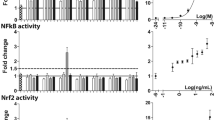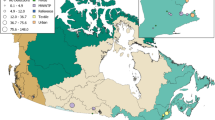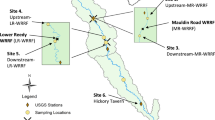Abstract
The endocrine disruptor Bisphenol A (BPA) is ubiquitous in both aquatic and surface sediment environments because it is continuously released into sewage wastewater effluent. The measurement of BPA at wastewater treatment plants is rarely performed even though the United States Environmental Protection Agency (EPA) states that current levels of environmental BPA could be a threat to aquatic organisms. Therefore, the aims of this study were to measure BPA levels in sewage wastewater at different collection points over a 1-year period and to compare the levels of BPA to 8-isoprostane, a human derived fatty acid, found in sewage wastewater. We analyzed pre-treated sewage samples collected from three source points located in different communities in the metropolitan Detroit area provided by the Detroit Water and Sewerage Department. Human urine samples were also used in the study. BPA and 8-isoprostane were measured using ELISA kits from Detroit R&D, Inc. BPA levels from the same collection point oscillated more than 10-fold over 1 year. Also, BPA levels fluctuated differentially at each collection point. Highly fluctuating BPA values were confirmed by LC/MS/MS. The concentration of BPA in sewage wastewater was ~100-fold higher than the concentration of 8-isoprostane, while urinary concentration was ~20-fold higher. Thus, BPA levels discharged into the sewage network vary among communities, and differences are also observed within communities over time. The difference in BPA and 8-isoprostane levels suggest that most of the BPA discharged to sewage wastewater might be derived from industries rather than from human urine. Therefore, the continuous monitoring of BPA could account for a better regulation of BPA release into a sewage network.


Similar content being viewed by others
Reference
Brewer, A. J., Ort, C., Banta-Green, C. J., Berset, J. D., & Field, J. A. (2012). Normalized diurnal and between-day trends in illicit and legal drug loads that account for changes in population. Environmental Science & Technology, 46(15), 8305–8314.
Castiglioni, S., Bijlsma, L., Covaci, A., Emke, E., Hernández, F., Reid, M., et al. (2013). Evaluation of uncertainties associated with the determination of community drug use through the measurement of sewage drug biomarkers. Environmental Science & Technology, 47(3), 1452–1460.
Daughton, C. G. (2012). Real-time estimation of small-area populations with human biomarkers in sewage. The Science of the Total Environment, 414, 6–21.
Fernandez, M. P., Ikonomou, M. G., & Buchanan, I. (2007). An assessment of estrogenic organic contaminants in Canadian wastewaters. Science of the Total Environment, 373, 250–269.
Flint, S., Markle, T., Thompson, S., & Wallace, E. (2012). Bisphenol A exposure, effects, and policy: a wildlife perspective. Journal of Environmental Management, 104, 19–34.
Fukazawa, H., Watanabe, M., Shiraishi, F., Shiraishi, H., Shiozawa, T., Matsushita, H., & Terao, Y. (2002). Formation of chlorinated derivatives of Bisphenol A in waste paper recycling plants and their estrogenic activities. J. Health Sciences, 48, 242–249.
Gatidoua, G., Thomaidisa, N. S., Stasinakisb, A. S., & Lekkas, T. D. (2007). Simultaneous determination of the endocrine disrupting compounds nonylphenol, nonylphenol ethoxylates, triclosan and bisphenol a in wastewater and sewage sludge by gas chromatography–mass spectrometry. Journal of Chromatography. A, 1138(1–2), 32–41.
Guerra, P., Kim, M., Teslic, S., Alaee, M., & Smyth, S. A. (2015). Bisphenol A removal in various wastewater treatment processes: operational conditions, mass balance, and optimization. Journal of Environmental Management, 1(152), 192–200.
Joiakim, A., Kaplan, D., Friedrich, K., Putt, D., Kim, H., (2013). Bisphenol-a (BPA) levels in liquid supernatants of canned foods determined by highly sensitive BPA ELISA. Society of Toxicology, Abstract book #2328.
Kang, J. H., & Kondo, F. (2002). Effects of bacterial counts and temperature on the biodegradation of Bisphenol A in river water. Chemosphere, 49(5), 493–498.
Lang, I. A., Galloway, T. S., Scarlett, A., Henley, W. E., Depledge, M., Wallace, R. B., & Melzer, D. (2008). Association of urinary Bisphenol A concentration with medical disorders and laboratory abnormalities in adults. JAMA, 300(11), 1303–1310.
Melcer, H., & Klecka, G. (2011). Treatment of wastewaters containing Bisphenol A: state of the science review. Water Environment Research, 83(7), 650–666.
Nie, Y., Qiang, Z., Zhang, H., & Adams, C. (2009). Determination of endocrine-disrupting chemicals in the liquid and solid phases of activated sludge by solid phase extraction and gas chromatography–mass spectrometry. Journal of Chromatography. A, 1216(42), 7071–7080.
Samaras, V. G., Stasinakis, A. S., Mamais, D., Thomaidis, N. S., & Lekkas, T. D. (2013). Fate of selected pharmaceuticals and synthetic endocrine disrupting compounds during wastewater treatment and sludge anaerobic digestion. Journal of Hazardous Materials, 15(244–245), 259–267.
Samaras, V. G., Thomaidis, N. S., Stasinakis, A. S., & Lekkas, T. D. (2011). An analytical method for the simultaneous trace determination of acidic pharmaceuticals and phenolic endocrine disrupting chemicals in wastewater and sewage sludge by gas chromatography–mass spectrometry. Analytical and Bioanalytical Chemistry, 399(7), 2549–2561.
Sánchez-Avilaa, J., Bonetb, J., Velascob, G., & Lacortea, S. (2009). Determination and occurrence of phthalates, alkylphenols, Bisphenol A, PBDEs, PCBs and PAHs in an industrial sewage grid discharging to a municipal wastewater treatment plant. The Science of the Total Environment, 407(13), 4157–4167.
Santos, J. M., Jurban, M., & Kim, H. (2015). Could sewage epidemiology be a strategy to assess lifestyle and wellness of a large scale population? Medical Hypotheses, 85(4), 408–411.
Staples, C. A., Dorn, P. B., Klecka, G. M., O’Block, S. T., & Harris, L. R. (1998). A review of the environmental fate, effects, and exposures of Bisphenol A. Chemosphere, 36, 2149–2173.
Tran, B. C., Teil, M. J., Blanchard, M., Alliot, F., & Chevreuil, M. (2015). BPA and phthalate fate in a sewage network and an elementary river of France. Influence of hydroclimatic conditions. Chemosphere, 119, 43–51.
US Environmental Protection Agency, (2011). Testing of Bisphenol A: advance notice of proposed rulemaking. Fed. Regist, 76, 143. 44535e44547.
Vogel, J. M. (2004). Tunnel vision: the regulation of endocrine disruptors. Policy Sciences, 37, 3e4.
Xu, E. G., Liu, S., Ying, G. G., Zheng, G. J., Lee, J. H., & Leung, K. M. (2014). The occurrence and ecological risks of endocrine disrupting chemicals in sewage effluents from three different sewage treatment plants, and in natural seawater from a marine reserve of Hong Kong. Marine Pollution Bulletin, 85(2), 352–362.
Ying, G. G., Kookana, R. S., Kumar, A., & Mortimer, M. (2009). Occurrence and implications of estrogens and xenoestrogens in sewage effluents and receiving waters from South East Queensland. The Science of the Total Environment, 407(18), 5147–5155.
Zhang, A., & Li, Y. (2014). Removal of phenolic endocrine disrupting compounds from waste activated sludge using UV, H2O2, and UV/H2O2 oxidation processes: effects of reaction conditions and sludge matrix. The Science of the Total Environment, 493, 307–323.
Zuccato, E., Chiabrando, C., Castiglioni, S., Calamari, D., Bagnati, R., Schiarea, S., et al. (2005). Cocaine in surface waters: a new evidence-based tool to monitor community drug abuse. Environmental Health, 5(4), 14.
Acknowledgments
The authors would like to thank the Lumigen Instrument Center, Wayne State University, (Detroit, MI) for the use of the Shimadzu Nextera X2 UHPLC-MS-MS which was purchased through support of a Shimadzu grant and the technical assistance provided by Johnna Birbeck and Nicole Lenca.
Author information
Authors and Affiliations
Corresponding author
Ethics declarations
Conflict of interest
Michael Jurban and Klaus Friedrich declare that they have no competing interests. Hyesook Kim is the president of Detroit R&D, Inc. and has a commercial interest. Julia M. Santos, David Putt and Aby Joiakin also work for Detroit R&D, Inc.
Rights and permissions
About this article
Cite this article
Santos, J.M., Putt, D.A., Jurban, M. et al. Differential BPA levels in sewage wastewater effluents from metro Detroit communities. Environ Monit Assess 188, 585 (2016). https://doi.org/10.1007/s10661-016-5593-8
Received:
Accepted:
Published:
DOI: https://doi.org/10.1007/s10661-016-5593-8




